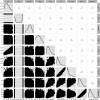A machine learning approach to predict daptomycin exposure from two concentrations based on Monte Carlo simulations
- PMID: 38501807
- PMCID: PMC11064575
- DOI: 10.1128/aac.01415-23
A machine learning approach to predict daptomycin exposure from two concentrations based on Monte Carlo simulations
Abstract
Daptomycin is a concentration-dependent lipopeptide antibiotic for which exposure/effect relationships have been shown. Machine learning (ML) algorithms, developed to predict the individual exposure to drugs, have shown very good performances in comparison to maximum a posteriori Bayesian estimation (MAP-BE). The aim of this work was to predict the area under the blood concentration curve (AUC) of daptomycin from two samples and a few covariates using XGBoost ML algorithm trained on Monte Carlo simulations. Five thousand one hundred fifty patients were simulated from two literature population pharmacokinetics models. Data from the first model were split into a training set (75%) and a testing set (25%). Four ML algorithms were built to learn AUC based on daptomycin blood concentration samples at pre-dose and 1 h post-dose. The XGBoost model (best ML algorithm) with the lowest root mean square error (RMSE) in a 10-fold cross-validation experiment was evaluated in both the test set and the simulations from the second population pharmacokinetic model (validation). The ML model based on the two concentrations, the differences between these concentrations, and five other covariates (sex, weight, daptomycin dose, creatinine clearance, and body temperature) yielded very good AUC estimation in the test (relative bias/RMSE = 0.43/7.69%) and validation sets (relative bias/RMSE = 4.61/6.63%). The XGBoost ML model developed allowed accurate estimation of daptomycin AUC using C0, C1h, and a few covariates and could be used for exposure estimation and dose adjustment. This ML approach can facilitate the conduct of future therapeutic drug monitoring (TDM) studies.
Keywords: AUC; Model informed precision dosing; Monte Carlo simulations; Pharmacometrics; TDM; XGBoost; artificial intelligence; daptomycin; machine learning; population pharmacokinetics.
Conflict of interest statement
The authors declare no conflict of interest.
Figures




References
Publication types
MeSH terms
Substances
LinkOut - more resources
Full Text Sources
Medical

